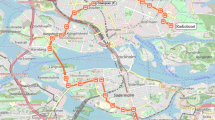Abstract
The operation time of external trucks in a container terminal is one of port operation key performance indicators concerned by port operators, external truck operators and related government authorities. With the traffic big data combined with the operation characteristics of the container terminal, the system dynamics method is used to build the simulation model of the operation system for external trucks. The simulation results of the operation time of external trucks are consistent with the actual situation, which provides an effective way to eliminate the “black box” of the operation time of the external trucks. The model can also be applied in multiple scenarios by using the traffic big data, and the simulation results can be adopted by the relevant organizations.
Similar content being viewed by others
Abbreviations
- C (ct) t :
-
Number of external trucks operated in a container terminal, vehicles/unit time
- C (sct) t :
-
Operation time of a external truck operated in a container terminal, unit time
- C (st) t :
-
Yard operation capacity for external trucks, vehicles/unit time
- C (y) t :
-
Yard operation capacity for internal and external trucks, vehicles/unit time
- C (yt) t :
-
Yard operation capacity for internal container trucks, vehicles/unit time
- D (y) :
-
Difficulty coefficient of yard operation
- N (at) t :
-
Number of external trucks in vehicles arriving at a container terminal per time unit
- N (ib) t :
-
Number of external trucks in vehicles from entrance gate to buffer area per time unit
- N (lt) t :
-
Number of external trucks in vehicles leaving from a container terminal per time unit
- N (ob) t :
-
Number of external trucks in vehicles from buffer area to yard per time unit
- N (og) t :
-
Number of external trucks in vehicles from entrance gate to the yard per time unit
- N (oy) t :
-
Number of external trucks in vehicles from yard to exit gate per time unit
- N (v) :
-
Number of trucks in vehicles planned to be operated in a container terminal per time unit
- t :
-
Sequence of unit time during the operation
- T (ct) t :
-
Total time of all external trucks operated in a container terminal per unit time
- V (ba) t :
-
Number of external trucks in vehicles in buffer area at the end of unit time
- V (gi) t :
-
Number of external trucks in vehicles in the entrance gate at the end of unit time
- V (go) t :
-
Number of external trucks in vehicles in exit gate at the end of unit time
- V (y) t :
-
Number of external trucks in vehicles in yard at the end of unit time
References
HAN X L. Resources allocation in container terminal charge/discharge operation [D]. Shanghai: Shanghai Maritime University, 2005 (in Chinese).
KAPLAN R S, ANDERSON S. Time-driven activity-based costing: A simpler and more powerful path to higher profits [M]. Boston: Harvard Business School Press, 2007.
PHAN M H, KIM K H. Collaborative truck scheduling and appointments for trucking companies and container terminals [J]. Transportation Research Part B: Methodological, 2016, 86: 37–50.
TENG T. Truck arrival volume prediction method research of container terminals [D]. Dalian: Dalian Maritime University, 2017 (in Chinese).
SHAO Q Q, JIN Z H, XING L. Simulation optimization of consolidation and configuration in container terminals based on cooperative appointment [J]. Journal of Transportation Systems Engineering and Information Technology, 2016, 16(4): 217–224 (in Chinese).
TORKJAZI M, HUYNH N, SHIRI S. Truck appointment systems considering impact to drayage truck tours [J]. Transportation Research Part E: Logistics and Transportation Review, 2018, 116: 208–228.
NADI A L, SHARMA S, SNELDER M, et al. Short-term prediction of outbound truck traffic from the exchange of information in logistics hubs: A case study for the port of Rotterdam [J]. Transportation Research Part C: Emerging Technologies, 2021, 127: 103111.
DU Y, ZHAO Y F. Classification and prediction of social container trucks in container terminal by decision tree method [J]. Industrial Engineering and Management, 2021, 26(1): 183–190 (in Chinese).
WANG J F, LU H P, PENG H. System dynamics model of urban transportation system and its application [J]. Journal of Transportation Systems Engineering and Information Technology, 2008, 8(3): 83–89 (in Chinese).
ZHAO P. Research on the allocation of resources for the container terminal based on system dynamics [D]. Dalian: Dalian Maritime University, 2012 (in Chinese).
Author information
Authors and Affiliations
Corresponding author
Rights and permissions
About this article
Cite this article
Du, Y., Zhao, Y. & Gao, D. Predictive Simulation of External Truck Operation Time in a Container Terminal Based on Traffic Big Data. J. Shanghai Jiaotong Univ. (Sci.) (2022). https://doi.org/10.1007/s12204-022-2415-8
Received:
Accepted:
Published:
DOI: https://doi.org/10.1007/s12204-022-2415-8




